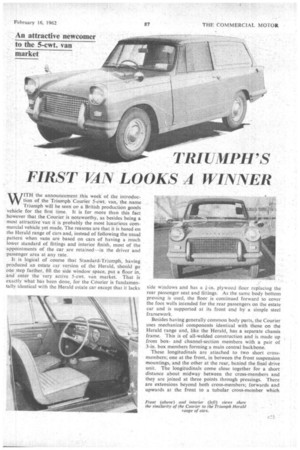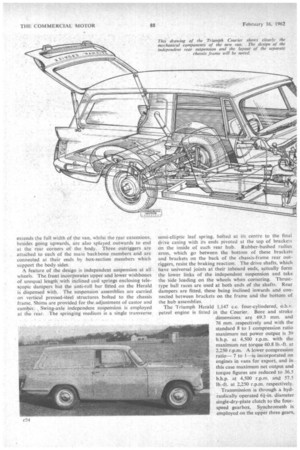TRIUMPH'S FIRST VAN LOOKS A WINNER
Page 53

Page 54

Page 56

If you've noticed an error in this article please click here to report it so we can fix it.
WITH the announcement this week of the introduction of the Triumph Courier 5-cwt. van, the narne Triumph will be seen on a British production goods vehicle for the first time. It is for more than this fact -however that the Courier is noteworthy, as besides being a most attractive van it is probably the most luxurious commercial vehicle yet made. The reasons are that it is based on the Herald range of cars and, instead of following the usual pattern when vans are based on cars of having a much lower standard of fittings and interior finish, most of the appointments of the car, are retained—in the driver and passenger area at any rate.
It is logical of course that Standard-Triumph, having produced an estate car version of the Herald, should go one step farther, fill the side window space, put a floor in, and enter the very active 5-cwt. van market. That is exactly what. has been done, for the Courier is fundamentally identical with the Herald estate car except that it lacks
side windows and has a i-in. plywood floor replacing the rear passenger seat and fittings. As the same body bottom pressing is used, the floor is continued forward to cover the foot wells intended for the rear passengers on the estate car and is supported at its front end by a simple steel framework.
Besides having generally common body parts, the Courier uses mechanical components identical with those on the Herald range and, like the Herald, has a separate chassis frame. This is of all-welded construction and is made up from boxand channel-section members with a pair of 3-in, box members forming a main central backbone.
These longitudinals are attached to two short crossmembers; one at the front, in between the front suspension mountings, and the other at the rear, benind the final drive unit. The longitudinals come close together for a short distance about midway between the cross-members and they are joined at three points through pressings. There are extensions beyond both cross-members; forwards and upwards at the front to a tubular cross-member which
extends the full width of the van, whilst the rear extensions, besides going upwards, arc also splayed outwards to end at the rear corners of the body. Three outriggers are attached to each of the main backbone members and are connected at their ends by box-section members which support the body sides.
A feature of the design is independent suspension at all wheels. The front incorporates upper and lower wishbones of unequal length with inclined coil springs enclosing telescopic dampers but the anti-roll bar fitted on the Herald N dispensed with. The suspension" assemblies are carried on vertical pressed-steel structures bolted to the chassis frame. Shims are provided for the_adjustment of castor and camber. Swing-axle independent suspension is employed at the rear. The springing medium is a single transverse semi-elliptic leaf spring, bolted at its centre to the final drive casing with its ends pivoted at the top of brackets on the inside of each rear hub. Rubber-bushed radius arms, which go between the bottom of these brackets and brackets on the back of the chassis-frame rear outriggers, resist the braking reaction. The drive shafts, which have universal joints at their inboard ends, actually form the lower links of the independent suspension and take the side loading on the wheels when cornering. Thrusttype ball races are used at both ends of the shafts. Rear dampers are fitted, these being inclined inwards and connected between brackets on the frame and the bottom of the hub assemblies.
The Triumph Herald 1,147 c.c. four-cylindered, o.h.v. petrol engine is fitted in the Courier. Bore and stroke dimensions are 69.3 mm. and 76 mm respectively and with the standard 8 to 1 compression ratio maximum net power output is 39 b.h.p. at 4,500 r.p.m. with the maximum net torque 60.8 lb.-ft. at 2,250 r.p.m. A lower compression ratio— 7 to 1—is incorporated on engines in vans for export, and in this case maximum net output and torque figures are reduced to 36.5 b.h.p. at 4,500 r.p.m. and 57.5 lb.-ft. at 2,250 r.p.m. respectively.
Transmission is through a hydraulically operated 6f-in, diameter single-dry-plate clutch to the fourspeed gearbox. Synchromesh is employed on the upper three gears, which have ratios of 2.158, 1.394 and 1 to 1. First and reverse gear ratios are the same-3.746 to 1. The engineand-gearbox unit is supported in the chassis frame at four points with rubber mountings on bath sides of the engine front bearer and a pair of closely-spaced rubber units below the gearbox extension.
From the gearbox, a large-diameter open propeller shaft passes over the frame to the final-drive unit. The latter is also flexibly mounted in the frame—at four points; two rubber bushes at the rear and rubber units at both sides at the front which support the ends of a flange plate bolted,to the nose of drive casing. The final-drive unit houses a conventional hypoid-bevei drive unit and differential. The standard ratio is 4.11 to 1.
Braking
Braking is by a Girling hydraulic system with twoleading-shoe units at the front wheels and leading-andtrailing-shoe units at the rear wheels. Front drums are 8 in. in diameter whilst the rear drums are 7 in. in diameter. All brake shoes are 11 in. wide so that the total lining area is 72 sq. in. The handbrake operates on the rear wheels only and the lever is mounted on the propeller shaft tunnel. Tyre equipment of the van is 5.60-13 (4-ply).
Rack and pinion steering is employed. The rack member acts as the centre portion of a three-piece track rod. Movement is transmitted to the pinion through a universal joint at the bottom of the steering shaft. The steering column itself is telescopic and the wheel has 4 in. of adjustment. A further 2 in. of downward movement is possible, but this is only taken up if the driver's body is thrown against the wheel in an accident.
Whilst the mechanical make-up of a new van is naturally interesting, it is the body of a vehicle which will be used mainly on delivery work that is of the most importance. From this aspect the Courier is well up to the standards of its contemporaries—the vans against which it will be competing. Capacity of the load space is 45 cu. ft. on a floor . area of 19 sq. ft. Although the carrying capacity is nominally 5 cwt., the recommended gross vehicle weight is 1 ton 4 cwt. and the estimated kerb weight 16.5 cwt. Therefore the total load including the driver can be 7.5 cwt. which means that with an average sized driver a 6-cwt. load can be carried, or a 5-cwt. load and a smallish passenger are possible.
To a certain extent, the attractive styling of the body results in disadvantages as far as the load space is concerned; the sides taper appreciably from above the waist line and the sharp slope at the rear will prevent the end foot or so-of the floor being used for carrying anything at all bulky. There are many advantages in the design, how
c26
ever. Not least of these is the method used to build the body. In this, a relatively small number of pressings are welded together to make a number of sub-assemblies which are then bolted together to make the complete body shell. The resultant simplification of body repairs will be obvious. The top-hinged rear door is also a good feature; it allows a large-sized window to be incorporated and helps to make loading and unloading easier.
The door is kept in the fully open position by a catch in the strut on the nearside. Both nearside and offside struts carry
spring-loaded counterbalance mechanisms for the 'door. Two catches for the door are located at the bottom edge; these have external handles. The offside one locks.
The body sides below the waist line extend beyond the line of the rear door, forming fins which house the rear flashers and stop and tail lights. The glasses of the lights are shaped to blend in with the bumper over-riders below them. These are integral with the body as also is the bumper which wraps round the sides of the body as far as the wheel cut-out. The driver's and passenger's doors are hinged at their forward edge. In addition to winding windows both doors have hinged front quarter lights. The front wings and the bonnet are assembled in one unit, hinged at the front, so that it can be pivoted forward for access to the engine and other units. Holding-down clips are located at the bottom of each side, behind the front wheels. The bumper at the front is also integral with the bodywork but, here, over-riders are bolted on.
In only three respects is the driver's and passenger's area of the Courier different from that of the Herald; on the Courier there is a little less padding in the seats (the pas senger's seat is, incidentally, a standard fitting); instead of being fully carpeted, only the gearbox cover has carpet, the floor in front of the seats being covered by moulded rubber mats; and instead of a veneered wood facia panel that on the Courier is of compressed -fibre with a cubby hole on the passenger's side. The speedometer is located above the steering column and the dial also incorporates a fuel gauge and warning• lights. Controls for the twin wipers and the headand side-light master switch and the combined ignition and starter switch are grouped around a pull-out ashtray in the centre of the facia. Sideand head-light operation and the flashing direction indicators are con trolled by levers on the steering column. Other items of equipment fitted as standard include an interior mirror as well as two wing-mirrors, a sun visor ( a second for the passenger's side costs an extra 10s.), two interior lights (one below the facia top rail and one above the rear door), and a spare wheel carried beneath the rearmost section of the floor.
In standard form the Courier costs £528. Extras available include a fresh, air heating and demisting unit which costs . £10 and windscreen washers, the cost of which is £1. Mounting points for these extras are incorporated in the standard model












































































































